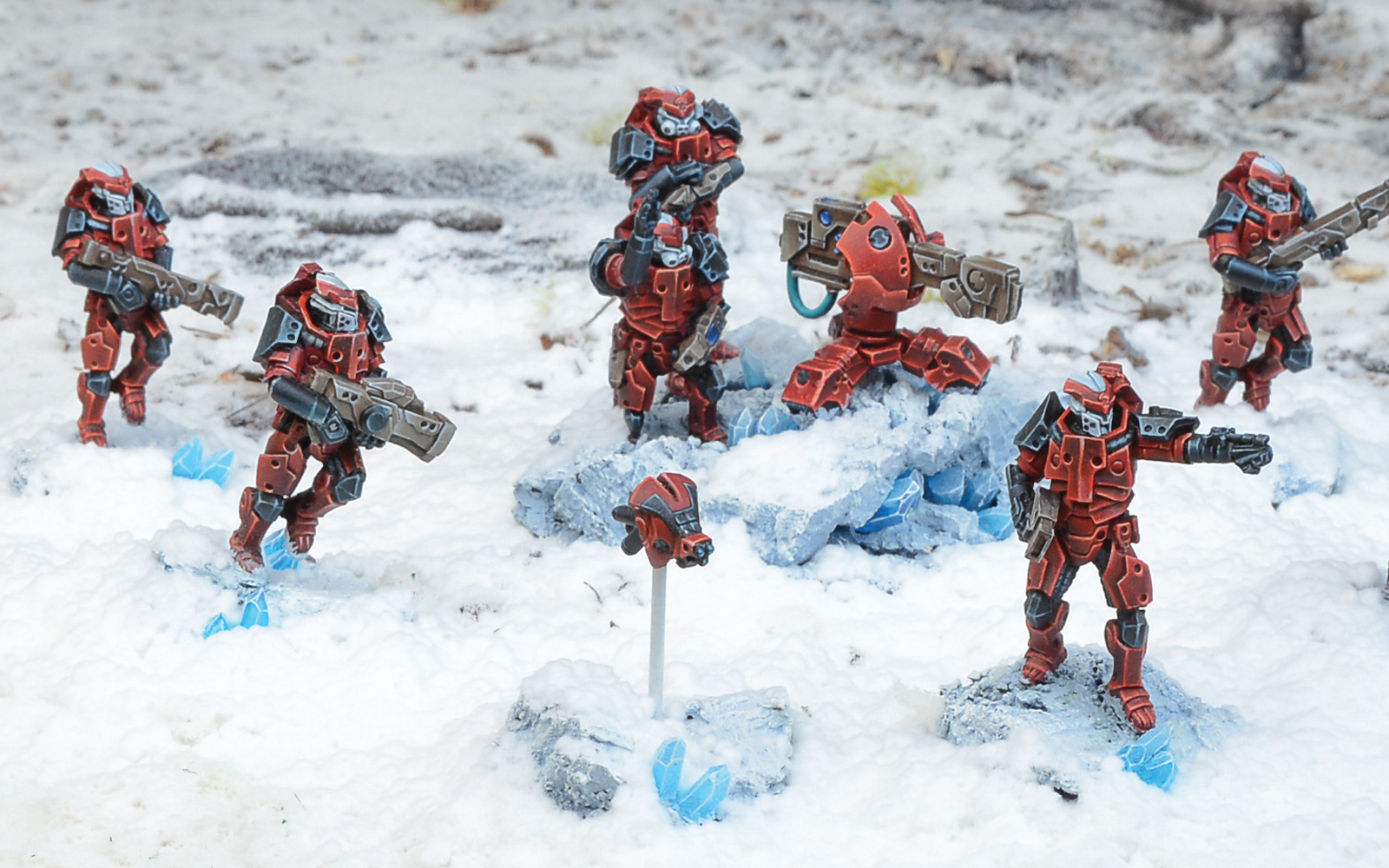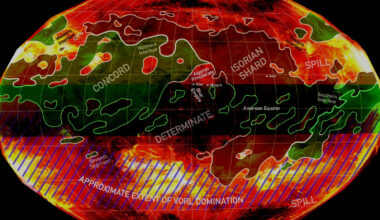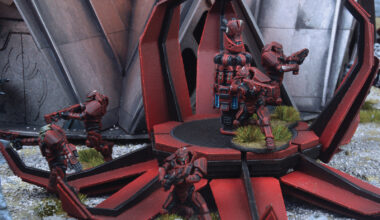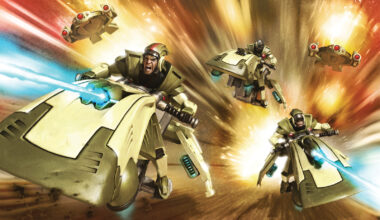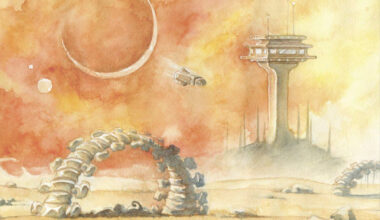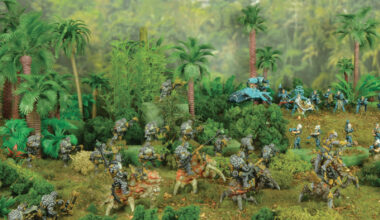The earlier articles in this series covered the major events in the Fifth Age of Antares and highlighted some of the major and minor empires and petty kingdoms that existed during the Warring Ages. The immediately previous article covered how to create your own area of the Fifth Age Antares on which to place campaigns or games.
This article starts the process of creating an army for your empire. We’ll also provide a point system based on that for Beyond the Gates of Antares (BtGoA) with which you can tailor the forces to your own models or your own empire.
As this is a tabletop wargame, we’ll start off with discussing the weapons available to armies of the Fifth Age!
Fifth Age Technology Overview
Fifth Age military technology is a far cry from that in use during the Seventh Age. Not only was the interim period between the Fourth and Fifth particularly long for many stars, but many planets also suffered greatly during the Fifth Age, sometimes being thrown back into barbarism from a fairly advanced technology level. As a result, there is a wide array of technology in use on the battlefield, from weapons that would not look out of place on 20th Century Old Earth to plasma weaponry that might resemble that of the Seventh Age.
Common to all such weapons is that they can be considered less powerful than those in the Seventh Age. This might be a problem were it not for the fact that Fifth Age armour fields were less common and far weaker than in later ages and that some troopers made up for a loss by having heavier armour plating.
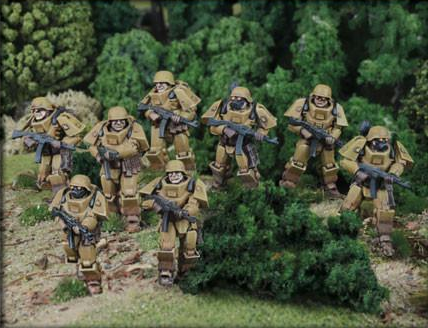
From our perspective, this means we can keep the same levels of Res and Strike Values that already exist in the Beyond the Gates of Antares rulebooks and army lists. When this is coupled with the more advanced medical facilities in the Seventh Age, it means special attributes like Leader become anachronistic, so perhaps we need to remove them from Fifth Age command models.
Of course, in comparison with Seventh Age units, a Fifth Age unit would no doubt be regarded as little more than Ferals!
But there is other technology that is not appropriate: whilst the 5th Age certainly had drones and buddies, the equivalent level of intelligence is not present. Basic buddies and probes are certainly present – spotters and targeters – but the more exotic or complex, such as synchroniser or shield buddies, are just not in the picture. Indeed, some drones might be considered to be about as reliable as Ghar flitters when facing the advanced technology of 5th Age Ha’Ruul or Isor.
Given the wide variety of weapons, equipment and armour, rather than go into thousands of different variations it helps if we place them into appropriate technological/capability groups: Retrograde (R), for those worlds in which technology degenerated, in which chemically-propelled projectiles abound and armour is purely physical; Mid- or widely-available (M), for those worlds and empires that were able to retain some degree of nanosphere-based technology and who may be able to use basic reflex fields; and Advanced (A), for those few worlds that kept their level of technology and were able to build a military capable of using that technology. We also use (B) to indicate that technology which is peculiar to Boromites.
Movement – Replacement
One set of rules we have to consider, however, are those concerned with movement. Fifth Age vehicles could be equipped with wheels, tracks, suspensor fields and – in the more unbelievable situations – walker or crawler legs like the Ghar. Some of the physical armour is also heavier, so will slow troopers down. What we don’t want, however, is to have troopers acquire the sharp distinctions of the Slow or Fast rules: instead, we use a movement stat measured in inches, ‘M’, which we’ll set at ‘5’ as a normal value – offering no change for the majority of troopers.
Fifth Age Troopers
Of course, the Isorian Senatex, Tsan Ra, Virai and Ghar do not exist in the Fifth Age – though there is nothing wrong with using the models you have to represent your particular Fifth Age army. In general, the more advanced troopers will look like 7th Age Algoryn, Freeborn and Ferals with the advanced troopers of the Isori and Ha’Ruul having armour resembling that of the 7th Age Concord. Most Boromites will resemble much of what they resembled in the 7th Age, though without access to energy weapons. Of top of these troopers are those from the more primitive worlds, such as Teveron’s Wastelanders before the rise of the Saviours. Such Retrograde peoples had a knowledge of more advanced technology but typically lacked the infrastructure to build advanced weapons: we can regard them as having weapons and equipment resembling from the early half of the 20th Century. This means some late-stage Bolt Action models and tanks would not be out of place on a Fifth Age table and on being given, or rediscovering, more advanced power sources, some worlds might experiment with weird and wonderful contraptions that could well be represented by Konflikt ’47 troopers and vehicles.

We’ll start off by looking at some basic, Fifth Age troopers. Rather than go into a myriad of details to cover every trooper active during the 5th Age, we provide a set of templates to use to model your own troops – just select the one closest to your own vision of empire. The templates are stat-ed deliberately to have a slight discount, but if you need to adjust the troopers slightly, pick a template and add or subtract a few points in each stat, adding +2 points for an increase in M, Acc, Co or Res and +1 in other areas: we strongly recommend this process is not used to over-stat a model!
All troopers have a basic, SV0 HtH attack with whatever minor weapons they have to hand; all points given are per model.
Askar are shown as they not only form a substantial minority in Vorl armies but are also present as mercenary units in a panhuman army. When used, their total trooper count should be less than the total of other morphs in that army.
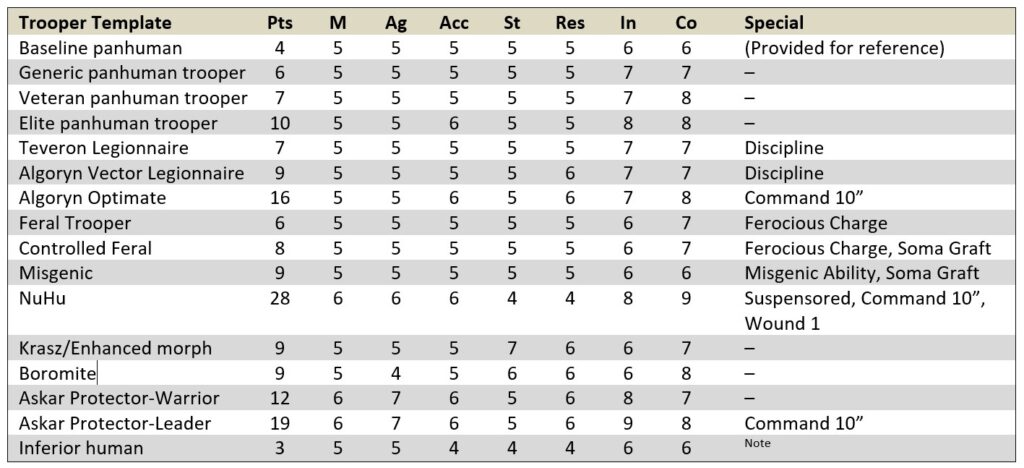
Command 10” (cost 5pts): Another unit with a model that is within 10” of this model can use this model’s Command stat (units normally use the greatest Co stat of any model in their unit). Follow costs 10pts.
Discipline (cost 1pts): The trooper adds +1 to Co for Break Tests and Recovery Tests if not using another model’s Co stat. Note that this does not apply to Order Tests.
Suspensored (cost 1pts): The model gains M6 and is classed as having suspensors when traversing terrain.
Ferocious Charge (cost 1pts): This is either applied to all models in a unit or none. The trooper will pass Init or Co tests to Charge on any roll bar a 10. Further, when charged, a unit whose members all have Ferocious Charge can react to an Assault starting from more than 5” away with a Countercharge – move the assaulters 5” then split the remaining distance between the two units which is where they meet and both units count as having charged (+1 St in first round of combat).
Soma Graft (cost 2pts): This is either applied to all models in a unit or none. Initially quiescent, it can be activated immediately prior to an Order Test or Break Test. When activated, the unit passes any Co test it takes except on a roll of a 9 or a 10. On a failed Co or Init test, the soma grafts short-circuit and the unit becomes uncontrolled (see BtGoA, p.121).
Misgenic Ability (cost 3pts): This is either applied to all models in a unit or none. As for BtGoA, p.129.
Wound 1 (costs 10pts; Wound 2 cost = 25pts): If the model fails a Res test (after any rerolls), then instead of falling casualty it is wounded. A model can take a number of wounds up to its Wound rating: once this rating is exceeded the model is removed as a casualty like anyone else. A wounded model must keep pins on its unit equal to the number of wounds it has received and cannot remove them by any means (so if taking one Wound, it must retain one pin – we find using a pin marker of a different colour can help).
Fifth Age Armour
Unfortunately for our Fifth Age troopers, armour technology was significantly enhanced by the developments in the 6th Age and by the IMTels and Tsan in the 7th Age. We still assume that most troopers have some form of basic body armour underneath their normal combat equipment, this basic body armour bringing them to Res 5, at least (perhaps Res 5.4!).
The knowledge of how to build reflex fields was generally available, even if the manufacturing facilities were sparse. More advanced field generators were available to the elite units of Isor and Ha’Ruul, their Duplex Field armour generating hyperlight envelopes around the underlying reflex fields to provide greater protection against weapons at longer ranges. Other forces experimented with multiple layered (ML) armour and armour fields, or complex shells consisting of layers of different composite material, but in both cases at the cost of limited movement and flexibility.
Retrograde and Feral armies were sometimes able to obtain Impact Fields equivalent to the mesh woven into 7th Age Freeborn’s cloaks. Such technology was rare and costly when traded for, so would only be given to elite units and commanders. Ascendency command units sometimes added impact armour and individual raiders are known to add such armour to help in the close-quarters fighting aboard ships or in colonies.
In the table below, the Scr? Column states whether or not the armour is subject to the effects of scrambler munitions or similar.
For example, the base cost for an Algoryn Legionnaire in the service of Teveron is 9 points, plus 2 for the Reflex armour they are always given for a base cost of 11 pts – the Algoryn models in the store would suit these fine, especially as they would be equipped with mag rifles. In a similar fashion, the basic troopers of the Isorian League and Ha’Ruul would be 6 points, plus 3 for their Duplex Field armour, for a total of 9 points – Concord troopers (in the store) being representative of such units. A basic trooper from a Retrograde world would also cost 6 points, but might perhaps not have any armour worth talking about or have heavy body armour for a total of 9 points: these could be represented by armoured Konflikt ’47 troopers (see the Legio Aquila or the German Heavy Infantry), though there are many models that could be used!
Order Dice
Now we have seen the wide range of stat values for troopers in a Warring Age unit, a potential problem is highlighted: that of an overwhelming number of cheap units. Order dice are the driving mechanic in Bolt Action-based games and too many of them can inordinately unbalance a game. This means that, unlike BtGoA, we have to give a cost to order dice.
Playtest experience suggests that with the above point values, +30 points per unit – or more correctly, per order dice – is about right. There are few multiple order dice (MOD) units or models in the 5th Age, so we’ll address them as we come to them.
Despite the order dice cost, however, we recommend that armies or your own selectors are built to have between 4-7 order dice at 500/600 points, perhaps 5-9 at 750 and around 5-10 at 1000 points.
Example Squad
For something like a Algoryn unit in one of the Teveron legions, this gives us the following. As can be seen, points values aren’t directly related to 7th Age units, though adding 30pts to a 7th Age unit might give a more relevant comparison! We’ll go over the availability of spotter buddies in a subsequent article, but they are regularly issued to Ascendency units, and Teveron Legions are equipped with mag weapons and expected to be highly adaptable.
Next Instalment
Next instalment, we’ll look at the classes and types of weapons available to 5th Age units. Rather than go into immense detail (there are way too many discrete weapons!) we’ll go through weapons weapon group-by-weapon group and give examples of the type of troopers given such weapons.
